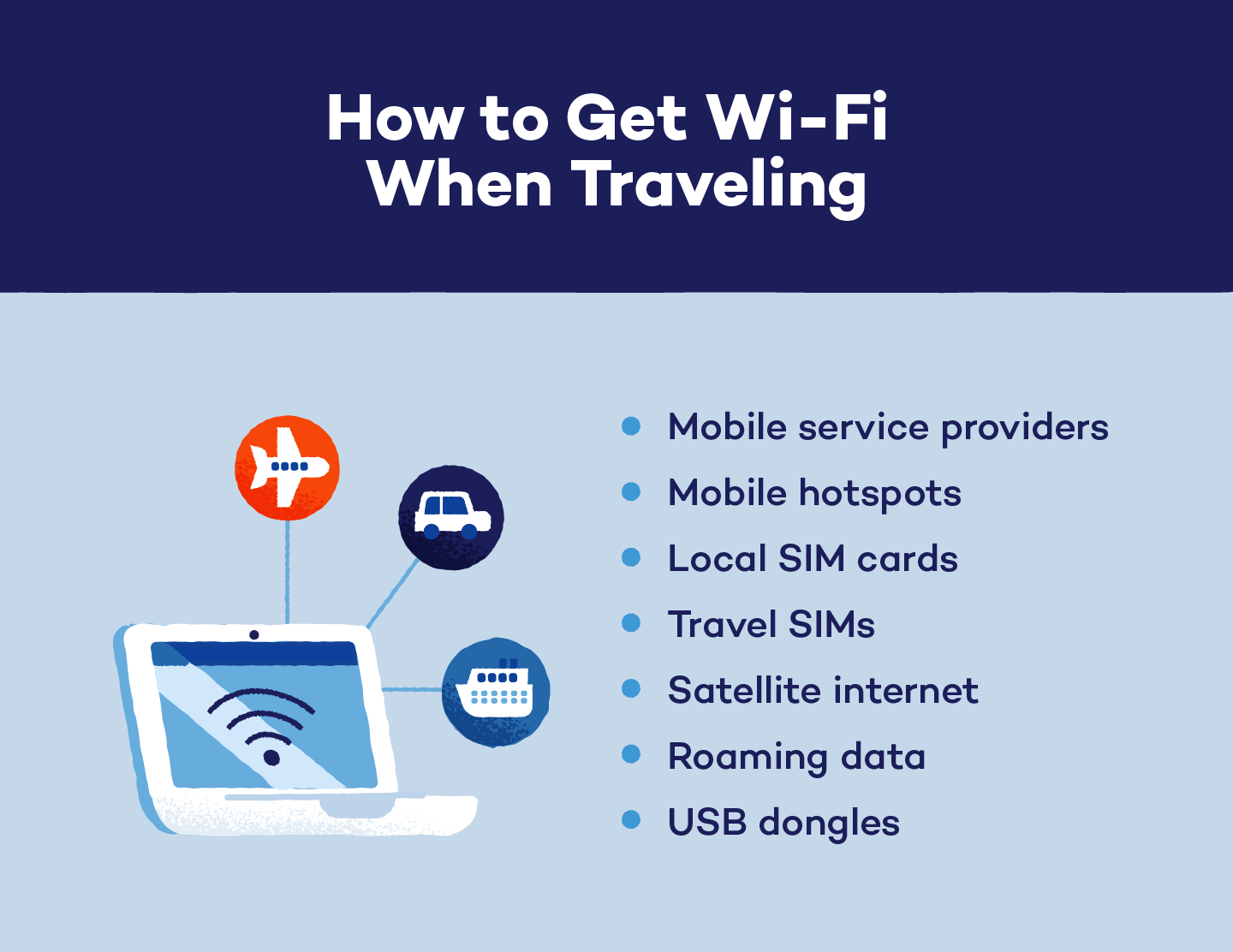Many travelers hope to go off-grid with their upcoming travels, but this doesn’t mean they want to be completely disconnected from reality — or the internet. The last thing you want to worry about is how to find internet while traveling, whether you’re sitting on the beach, trekking through the mountains or eating a new culinary dish.
If you’re looking to surf the internet safely while on holiday or simply need Wi-Fi to get to your destination, our 12 options below can help you get the best internet for traveling.
1. Mobile Service Providers
Before jetting off, contact your mobile carrier to see what — if any — type of data plans they may offer for travelers. Most major cellular carriers in the U.S. have agreements with foreign telecom companies, so getting an international plan added to your account might help you avoid other costly options.
Some service providers also have hotspot options for smart devices, which can be used to connect additional devices to Wi-Fi when traveling. You can discuss this option with your carrier when inquiring about international plans.
2. Mobile Hotspots
Mobile hotspots are physical, standalone devices that can create local internet hotspots for users. These devices can also be used by RV travelers for better internet reception.
There are two ways you can get a mobile hotspot:
- You can rent a mobile hotspot where prices depend on the amount of data you want, where you are traveling and how long you will be gone.
- You can buy a mobile hotspot where prices depend on the make, model and amount of data you want.
Mobile hotspots are a great option for family vacations because they allow users to connect multiple devices at once. However, they can be expensive, and they only work when devices are within range.
3. Local SIM Cards
As a more cost-effective solution, consider buying a local SIM card for the places you are traveling to. Usually, you will need to buy this when you arrive at your destination, but it’s sometimes possible to buy SIM cards before you depart. Check your destination’s local regulations about SIM card purchases before pursuing this option.
4. Travel SIMs
Travel SIMs — or roaming SIMs — are specifically designed to provide users with internet for travel. These SIM cards don’t need to be switched in and out of a device while traveling because they can operate on more than one network. This option can be more expensive than purchasing a local SIM card, but it can also be a great solution for users with outrageous international plan prices.
5. Satellite Internet
If you need to get online while traveling by RV, boat or another large transport device, satellite internet is a potential international internet solution. While satellite receivers need to be mounted to an object, need a clear view of the sky and are often more expensive than other service options, they can provide internet for travel when mobile hotspots can’t.
6. Roaming Data
One of the easiest ways to get internet on the road is to use roaming data offered by a cell service provider. This can be costly — especially if you’re traveling for extended periods — but it’s usually instant and fairly reliable.
7. USB Dongles
If you are working abroad and need to connect to the internet, a USB dongle is a safe option. While these devices sometimes have limited speed and stability, they offer protected internet access for laptops and other desktop devices. Additionally, dongles need compatible SIM cards, so they aren’t always the most practical option.
8. eSIMs
Embedded SIMs (eSIMs) let you activate a mobile data plan digitally without a physical SIM card. Before your trip, check if your phone supports eSIM and purchase a plan from your provider. Activate the eSIM through the provider’s app and switch to it when you arrive at your destination for instant internet access.
9. Public Wi-Fi
Many places, like cafes, restaurants, libraries and shopping malls, offer free public Wi-Fi. Use apps like WiFi Map or Instabridge to locate nearby networks. Always check with staff for the official network name to avoid connecting to unsecured hotspots. For security, use a VPN and avoid accessing sensitive information like online banking.
10. Wi-Fi Rental Services
Wi-Fi rental services provide portable hotspots that let you connect multiple devices to the internet without worrying about draining your mobile data. Companies like Global WiFi Hotspot or TravelWiFi offer rental options with daily or monthly plans. Order the device before your trip and pick it up at the airport or have it shipped to your accommodation.
11. Internet Cafes and Co-Working Spaces
If you need reliable internet for work, look for internet cafes or co-working spaces. Websites like Workfrom or Coworker can help you find work-friendly locations with high-speed Wi-Fi. Many co-working spaces offer day passes, allowing you to work comfortably while traveling.
12. Tethering From Another Device
If you have a second phone, tablet or a friend with an active data plan, you can tether their mobile connection via a personal hotspot. To enable this, go to your phone’s settings, find the hotspot or tethering option and share the connection via Wi-Fi, Bluetooth or USB. Keep an eye on data usage, as tethering can quickly consume mobile data.

Tips and Tricks for Getting Internet for Travel
Finding or carrying Wi-Fi when traveling comes with a few precautions. To keep your information safe and to stay safe from ransomware attacks when you’re away from home, follow these tips:
- Avoid public Wi-Fi networks: Public Wi-Fi can be risky, as poorly managed networks may expose your data to hackers or network administrators. Avoid connecting unless necessary.
- Use a VPN: If you must use public Wi-Fi, connect through a trusted VPN to encrypt your data and protect your privacy.
- Be aware of juice jacking: Public charging stations may contain malware that can compromise your device. Use your own AC adapter or a USB data blocker, and never grant access if prompted to “trust” a public USB connection.
- Bring backups: Keep important documents stored digitally and physically. Carry spare charging cables, power banks and backup devices in case of loss, theft or technical issues.
- Prepare maps and documents: Download offline maps and store essential documents securely before traveling. This ensures access even when you’re disconnected from the internet.
Traveling should be a time to relax or discover new places. The last thing you want to worry about is staying connected to friends and family or cybercriminals ruining your vacation. Protect your devices with a premium defense plan from Panda Security so you can enjoy Wi-Fi when traveling while keeping your mind at ease.
FAQ
Can You Use the Internet While on a Plane?
Yes, many airlines offer in-flight Wi-Fi, but the quality and cost vary. Some provide free basic browsing, while others charge for faster speeds or streaming access. Check with your airline before your flight and consider downloading content in advance in case of slow or unavailable connections.
Is Portable Wi-Fi Worth It?
Portable Wi-Fi can be worth it if you need a reliable internet connection while traveling, especially in areas with limited public Wi-Fi or expensive roaming charges. It allows multiple devices to connect, but costs and coverage depend on the provider. If you travel frequently or work remotely, a portable Wi-Fi device can be a smart investment.
How Do I Get Internet on My Phone When I’m Away From Home?
To get internet on your phone while away from home, you can use mobile data from your carrier, connect to a trusted Wi-Fi network or use a mobile hotspot. If you’re traveling internationally, consider getting a local SIM card, an eSIM or a travel SIM to avoid high roaming fees.
For more flexibility, you can rent a portable Wi-Fi device or tether from another phone. When using public Wi-Fi, always enable a VPN to protect your data. Downloading offline maps and essential documents in advance can also help you stay prepared when a connection isn’t available.







